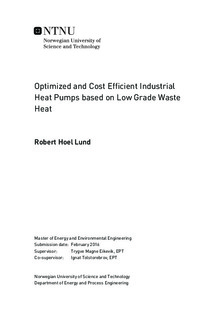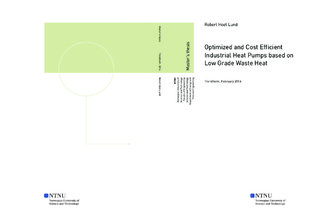| dc.description.abstract | The industrial sector is a large consumer of energy. Globally, this sector accounts for over half of the energy used. As anthropogenic emissions increase, and the consequences of these emissions become more evident, the incentive for energy reduction is clear. Heat pumps are readily available for low temperature applications in the residential sector, but has yet to make a breakthrough in industry. This is in stark contrast to the energy and cost savings such installations can induce.
To make heat pumps more attractive for industrial applications, it is important to demonstrate their potential. This master thesis investigates one such case, namely the implementation of a high temperature heat pump in a distillation plant. The heat pump will fulfill two purposes. First, it will cool down a waste stream to allow operation during warm summer months. Due to environmental restrictions, the availability of cooling water from a nearby river is restricted. Secondly, it will replace bought energy by using the condenser heat to preheat a distillation feed.
A vapour compression cycle was simulated by a model made in EES. Suitable natural working
fluids for high temperature applications were investigated with respect to cycle performance and their influence on component design. The case investigated gave the boundary conditions for the model, e.g. temperature levels and heat duty. In addition, an economic model was implemented to optimize the heat pump with respect to the total system costs, including component costs and the energy efficiency of the system.
The working fluid with the best performance was n-butane, with a coefficient of performance
close to 6. The requirement for this was a large evaporator which gave a small pinch temperature between the working fluid and water. The added investment costs of a larger evaporator could be justified by the reduced total costs due to lower operational costs. | |

